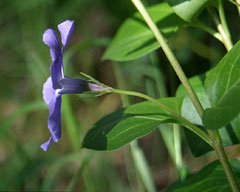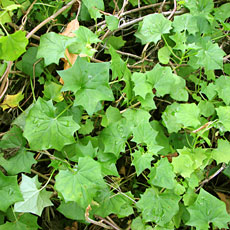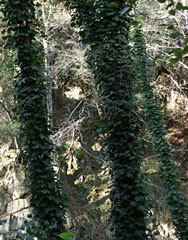Invasive Weed Survey Trip in the Arroyo Seco
by Cliff McLean
(reprinted with permission from the The Paintbrush, January-February 2009, San Gabriel Mountains Chapter of the California Native Plant Society)
|
On October 25, 2008, six members of the chapter made a 9 mile hike — from the Switzer Picnic Area, along the Angeles Crest Highway, down-canyon to Altadena — to survey the invasive weeds in the Arroyo Seco. This well-known and heavily used canyon in the San Gabriel Mountains has been overtaken by a number of invasive plants over the last few decades, as described in Gabi McLean’s article, Today's Arroyo Seco, in the January-February, 2008 issue of The Paintbrush. Our mission was to find out just how bad it was in the upper portions of the canyon. We already knew that major areas of the lower portion had been overwhelmed by invasives. Armed with GPS units and clipboards, Mickey Long, Bill Fitzpatrick, Shirley Imsand, Jennifer Pilapil, Gabi, and I began our hike. The species that we focused on were Cape Ivy (Delairea odorata), English Ivy (Hedera helix), Periwinkle (Vinca major), and Eupatory (Ageratina adenophora). We found lots of each of them. Each stand was recorded for species, GPS coordinates, elevation, and size estimate. 
In fact, we found a major population of Periwinkle before we got out of the Switzer picnic area parking lot. Periwinkle, like English Ivy, was widely planted around cabins and campgrounds in the early part of the Twentieth Century. What started as attractive reminders of the cities eventually became difficult problems. We encountered major populations of English Ivy about one mile downstream, at Switzer’s Campground and at Oakwilde, the latter about 4.5 miles from our starting point. Fortunately, while Periwinkle and English Ivy are very dense and spreading where they were planted, they did not disperse as readily as the other target plants. They are not as much of a problem in the upper Arroyo as they are farther downstream. 
© Gabi McLean Eupatory, which is familiar to everyone who hikes in our local canyons, spreads through prolific production of seeds that are carried in the wind or water. As a result, we found Eupatory in scattered patches in the canyon bottom most of the way. This pest plant is not yet as dense in the upper parts of the canyon as it is in many other canyons in the front range of the San Gabriels, but it has a strong start. |

© Cliff McLean Cape Ivy was introduced into California only in the 1950s, but has become a major problem. It spreads to new areas by growing from root and stem fragments. Because these broken bits can be easily carried downstream by the flowing streams, it is important to eradicate it from the top of the canyon first. We found the first Cape Ivy in the debris basin above a large dam about one mile below Oakwilde. 
© Gabi McLean In the same debris basin, the English Ivy is extremely thick and threatens the survival of many of the Coast Live Oak trees. We also found a number of other invasive plants here: Himalayan Blackberry (Rubus discolor) and Spanish Broom (Spartium junceum) were very well established, while Tamarisk and Pampas Grass were getting a toehold. Below the dam, we encountered the full invasive capabilities of our target plants. From there to Altadena, about 3.5 miles away, the Arroyo Seco is inundated by huge, dense patches of Cape Ivy, Periwinkle, Eupatory and English Ivy. Very little of the original canyon floor can be seen. Where a patch of one pest ends, a patch of another begins. Not only do the weeds cover the ground, but the English and Cape Ivies grow over shrubs and up into the trees, where they can block the sunlight completely. After the Paul Little picnic area, we needed to hurry to get to our cars before dark, so we stopped collecting data. We already knew more than we wanted to know about the invasive plants there. This is the infestation of the Arroyo that has prompted us to undertake a major project to control the invaders. We will use the GPS data to plot detailed location data. As we get the project underway, we will need the efforts of a lot of people who care about the San Gabriel Mountains and their beautiful canyons. In spite of the weeds, the hike was not without its pleasures. We were happy to find that the rare Greata’s Aster (Aster greatae) is growing in more locations than we knew about. In the section of chaparral that the trail took us through, we discovered a few Bush Poppies (Dendromecon rigida), as well as the first California Barberry (Mahonia pinnata) that Gabi and I have seen in the San Gabriel Mountains. |
Keywords: Gabi McLean, Cliff McLean, Gabriele McLean, Clifford McLean, Nature at Hand, Gabi Horn, Gabriele Horn, Plants of the San Gabriel Mountains: Foothills and Canyon, Interpretive Guide on CD, Plants of the San Gabriel Foothills and Canyons, California native plants, Pasadena, Los Angeles, Los Angeles County, San Gabriel Valley, Southern California, Covina, natural, nature photography, photograph, environmental education, naturalist, docent, hike, hiking, CD-ROM, California native garden, gardening, flowers, wildflowers, San Gabriel Mountains, Angeles National Forest, California Native Plant Society, CNPS, Eaton Canyon Nature Center Associates, ECNCA, Arroyo Seco, invasive weeds, invasive plants